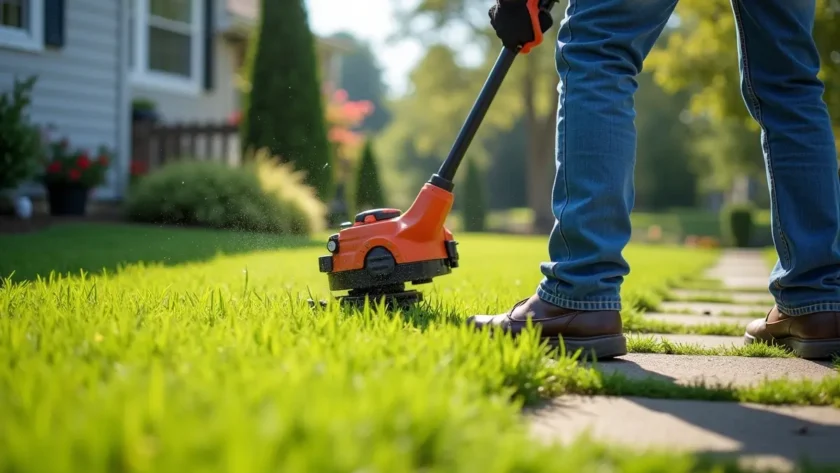You might think your weed eater is only good for trimming grass around fences and flower beds, but it can actually do a lot more than that. Whether you’re already using one or just pulled it out of the shed for the first time this season, it’s worth knowing how much potential it really has.
Contents
- 1 1. It Can Edge Your Lawn Like a Pro
- 2 2. It Can Clear Overgrown Bushes and Brush
- 3 3. It Can Handle Tight Spots Where a Mower Can’t Go
- 4 4. It Can Take Down Tall Grass—Without a Whipper Snipper
- 5 5. It Can Cut Through Weeds in Gravel Driveways
- 6 6. It Can Maintain Garden Edges Without Digging
- 7 7. It Can Even Lightly Dethatch in a Pinch
- 8 8. It Can Be Used for Quick Cleanup After Mowing
- 9 9. It’s Great for Touch-Ups Between Mows
- 10 More Than Just a Grass Trimmer
1. It Can Edge Your Lawn Like a Pro
Most people mow their lawns, then call it a day. But edging? That’s what gives your lawn that clean, tidy, professional look.
Your weed eater can double as an edger without buying any extra tools. All you have to do is flip it vertically so the string spins up and down instead of side to side. With a steady hand and a bit of patience, you can trace along garden beds, paths, and driveways to carve out crisp, defined borders.
The key is to go slowly. Don’t rush it, especially if it’s your first time. Let the trimmer line skim the surface and work its way into the edge.
2. It Can Clear Overgrown Bushes and Brush
Think your weed eater is too lightweight for heavy jobs? It might surprise you. With a thicker trimmer line or a brush-cutting attachment (if your model supports it), your weed eater can slice through more than just grass.
This comes in handy when you’re tackling:
- Weedy back corners
- Overgrown fence lines
- Stray saplings
- Thick ground cover that a mower can’t reach
For this kind of work, make sure you’re wearing long pants, goggles, and enclosed shoes, debris tends to fly when you’re cutting through thicker stuff.
3. It Can Handle Tight Spots Where a Mower Can’t Go
Lawns aren’t always wide open. Between trees, garden beds, play equipment, and pathways, there are always areas your mower just can’t reach. That’s where your weed eater becomes the MVP.
Because it’s lightweight and easy to manoeuvre, you can get into those awkward corners and edges without tearing up the lawn or damaging plants.
And if your yard has gravel or stepping stones mixed into the landscape, using your trimmer carefully around them helps maintain the space without accidentally kicking rocks or damaging your mower blades.
4. It Can Take Down Tall Grass—Without a Whipper Snipper
You know that thick, tall grass that’s been ignored for a little too long? Most people assume you need a brush cutter or heavy-duty machine to deal with it.
But a weed eater, when used right, can handle it. You just need to adjust your technique:
- Tilt the head at an angle
- Start trimming from the top of the grass
- Work your way down in layers
Trying to power straight through knee-high grass won’t do much and can burn out your motor. Layering your cut lets the machine work at its pace—and saves you the cleanup headache.
5. It Can Cut Through Weeds in Gravel Driveways
Gravel driveways look great when they’re clean. But when weeds start sprouting, they lose their appeal fast.
Instead of pulling weeds by hand or using chemicals, your weed eater can take them out in seconds. Go slow and keep the trimmer low, just above the surface. That way, you hit the weeds at the root while avoiding kicking up too many stones.
Just be careful around parked cars or glass, as gravel has a habit of flying when it catches the line.
6. It Can Maintain Garden Edges Without Digging
You don’t always need a spade to redefine your garden edges. If the soil isn’t too hard and the borders are already established, you can run your trimmer right along the edge to keep everything neat.
It won’t cut through tough roots or reshape a garden, but it can absolutely keep lines clean and stop lawn grass from creeping in.
A few minutes of upkeep every fortnight makes a big difference—and saves you from bigger maintenance jobs later.
7. It Can Even Lightly Dethatch in a Pinch
This one’s a bit of a bonus. If your lawn’s looking patchy or a bit choked out, it could be due to thatch buildup. Normally, you’d want a proper dethatcher, but if you don’t have one, your weed eater can do a light version.
Use a plastic or wire dethatching head if compatible, and run it across the lawn lightly. It’ll pull up dead material sitting on top without tearing up healthy grass.
It’s not a full dethatch, but it’s better than leaving the buildup to smother your lawn.
8. It Can Be Used for Quick Cleanup After Mowing
After mowing, sometimes you’re left with clippings scattered around hard surfaces. Instead of grabbing a broom or blower, your weed eater can help tidy things up.
By holding it at a low angle and running it across the edge of patios, paths, or decks, you can quickly clear away light grass debris.
It’s not meant for full clean-up jobs, but when you’re just after a quick sweep, it works.
9. It’s Great for Touch-Ups Between Mows
Don’t want to drag the mower out every week?
If the lawn’s only patchy in a few spots or you’ve just got some fast-growing edges, your weed eater can help you stay on top of it without doing a full mow. It’s fast, convenient, and perfect for those in-between maintenance days.
This is especially handy in warmer months, when certain parts of your lawn grow quicker than others.
More Than Just a Grass Trimmer
Weed eaters are seriously underrated. They’re often seen as a finishing tool, something you use after the mower, but in reality, they’re one of the most flexible tools in the shed.
Whether you’re edging, cleaning up, cutting through tall grass, or maintaining tight spots, knowing what your weed eater can do makes yard work faster and easier.




